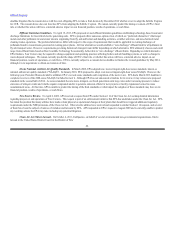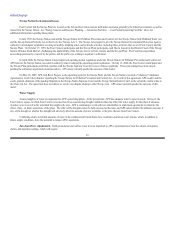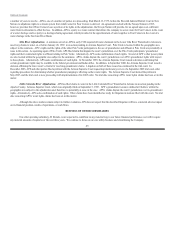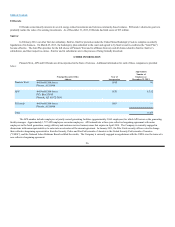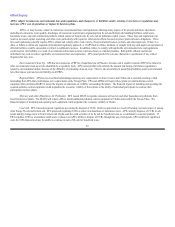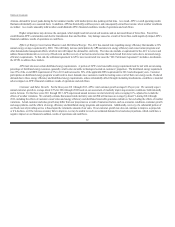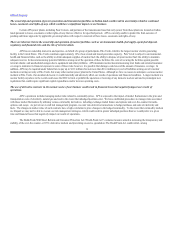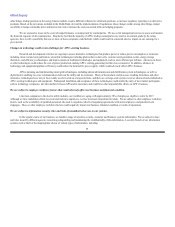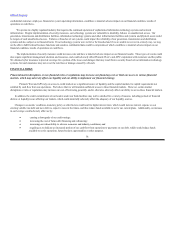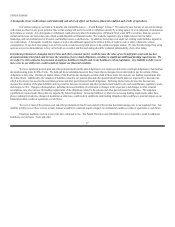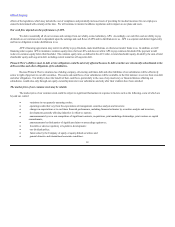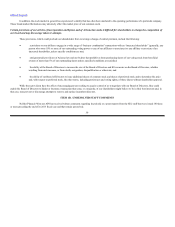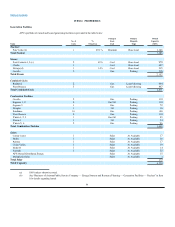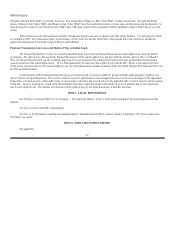APS 2013 Annual Report Download - page 35
Download and view the complete annual report
Please find page 35 of the 2013 APS annual report below. You can navigate through the pages in the report by either clicking on the pages listed below, or by using the keyword search tool below to find specific information within the annual report.
Table of Contents
Arizona, demand for power peaks during the hot summer months, with market prices also peaking at that time. As a result, APS’s overall operating results
fluctuate substantially on a seasonal basis. In addition, APS has historically sold less power, and consequently earned less income, when weather conditions
are milder. As a result, unusually mild weather could diminish APS’s financial condition, results of operations and cash flows.
Higher temperatures may decrease the snowpack, which might result in lowered soil moisture and an increased threat of forest fires. Forest fires
could threaten APS’s communities and electric transmission lines and facilities. Any damage caused as a result of forest fires could negatively impact APS’s
financial condition, results of operations or cash flows.
Effects of Energy Conservation Measures and Distributed Energy. The ACC has enacted rules regarding energy efficiency that mandate a 22%
annual energy savings requirement by 2020. This will likely increase participation by APS customers in energy efficiency and conservation programs and
other demand-side management efforts, which in turn will impact the demand for electricity. The rules also include a requirement for the ACC to review and
address financial disincentives, recovery of fixed costs and the recovery of net lost income/revenue that would result from lower sales due to increased energy
efficiency requirements. To that end, the settlement agreement in APS’s most recent retail rate case (the “2012 Settlement Agreement”) includes a mechanism,
the LFCR, to address these matters.
APS must also meet certain distributed energy requirements. A portion of APS’s total renewable energy requirement must be met with an increasing
percentage of distributed energy resources (generally, small scale renewable technologies located on customers’ properties). The distributed energy requirement
was 25% of the overall RES requirement of 3% in 2011 and increased to 30% of the applicable RES requirement for 2012 and subsequent years. Customer
participation in distributed energy programs would result in lower demand, since customers would be meeting some or all of their own energy needs. Reduced
demand due to these energy efficiency and distributed energy requirements, unless substantially offset through ratemaking mechanisms, could have a material
adverse impact on APS’s financial condition, results of operations and cash flows.
Customer and Sales Growth. For the three years 2011 through 2013, APS’s retail customer growth averaged 1.0% per year. We currently expect
annual customer growth to average about 2.5% for 2014 through 2016 based on our assessment of modestly improving economic conditions, both nationally
and in Arizona. For the three years 2011 through 2013, APS experienced annual increases in retail electricity sales averaging 0.1%, adjusted to exclude the
effects of weather variations. We currently estimate that annual retail electricity sales in kWh will increase on average by about 1% during 2014 through
2016, including the effects of customer conservation and energy efficiency and distributed renewable generation initiatives, but excluding the effects of weather
variations. Actual customer and sales growth may differ from our projections as a result of numerous factors, such as economic conditions, customer growth
and usage patterns, and the effects of energy efficiency and distributed energy programs and requirements. Additionally, recovery of a substantial portion of
our fixed costs of providing service is based upon the volumetric amount of our sales. If our customer growth rate does not continue to improve as projected,
or if it declines, or if the Arizona economy fails to improve, we may be unable to reach our estimated demand level and sales projections, which could have a
negative impact on our financial condition, results of operations and cash flows.
32


